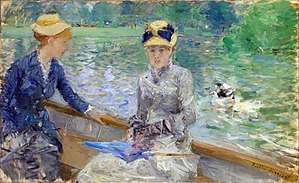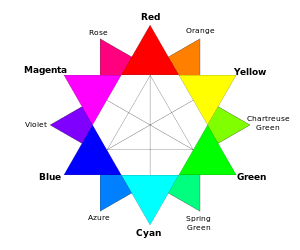Cerulean
Cerulean (/səˈruːliən/), also spelled caerulean, is a shade of blue ranging between azure and a darker sky blue.
blue |
cerulean |
teal |
| Cerulean | |
|---|---|
| Hex triplet | #007BA7 |
| sRGBB (r, g, b) | (0, 123, 167) |
| CMYKH (c, m, y, k) | (100, 26, 0, 35) |
| HSV (h, s, v) | (196°, 100%, 65%) |
| Source | [1] |
| ISCC–NBS descriptor | Strong greenish blue |
| B: Normalized to [0–255] (byte) H: Normalized to [0–100] (hundred) | |
| Cerulean (RGB) | |
|---|---|
| Hex triplet | #0040FF |
| sRGBB (r, g, b) | (0, 63, 255) |
| CMYKH (c, m, y, k) | (100, 75, 0, 0) |
| HSV (h, s, v) | (225°, 100%, 100%) |
| Source | [Unsourced] |
| ISCC–NBS descriptor | Vivid blue |
| B: Normalized to [0–255] (byte) H: Normalized to [0–100] (hundred) | |
The first recorded use of cerulean as a colour name in English was in 1590.[1] The word is derived from the Latin word caeruleus, "dark blue, blue, or blue-green", which in turn probably derives from caerulum, diminutive of caelum, "heaven, sky".[2]
"Cerulean blue" is the name of a pigment. The pigment was discovered in the late eighteenth century and designated as cerulean blue in the nineteenth century.
| Cerulean Blue | |
|---|---|
| Hex triplet | #2A52BE |
| sRGBB (r, g, b) | (42, 82, 190) |
| CMYKH (c, m, y, k) | (87, 74, 0, 0) |
| HSV (h, s, v) | (224°, 78%, 75%) |
| Source | Maerz and Paul[3] |
| ISCC–NBS descriptor | Vivid blue |
| B: Normalized to [0–255] (byte) H: Normalized to [0–100] (hundred) | |
Cerulean blue pigment

In classical times, the word caerulum was used to describe blue pigments, particularly mixtures of copper and cobaltous oxides, like azurite and smalt. These early attempts to create sky blue colours were often less than satisfactory due to a limited saturation and the tendency to discolour in reaction with other pigments. See also Tekhelet.

The pigment Cerulean blue was discovered in 1789 by the Swiss chemist Albrecht Höpfner.[4] Subsequently, there was a limited German production under the name of Cölinblau. It was in 1860 first marketed in the United Kingdom by colourman George Rowney, as "coeruleum". Other nineteenth century English pigment names included "ceruleum blue" and "corruleum blue".
Pigments through the ages shows a "Painted swatch of cerulean blue" that is representative of the actual cobalt stannate pigment. This colour swatch matches the colour shown in the colour box at right.[5] See also painted swatch and crystals of cerulean blue at ColourLex.[6]
The primary chemical constituent of the pigment is cobalt(II) stannate.[7][8][9] The precise hue of the pigment is dependent on a variable silicate component. The pigment is very expensive.
When the pigment cerulean blue (shown in the colour box to the left) was discovered, it became a useful addition to Prussian blue, cobalt blue and synthetic ultramarine which already had superseded the prior pigments.
It is particularly valuable for artistic painting of skies because of its hue, its permanence, and its opaqueness.[10] Berthe Morisot painted the blue coat of the woman in her Summer's Day, 1879 in cerulean blue in conjunction with artificial ultramarine and cobalt blue.[11]

Today, cobalt chromate is sometimes marketed under the cerulean blue name but is darker and greener (Rex Art colour index PB 36) than the cobalt stannate version (colour index PB 35). The chromate makes excellent turquoise colours and is identified by Rex Art and some other manufacturers as "cobalt turquoise".[12][13]
Other colour variations
Pale cerulean
| Cerulean (Pantone) | |
|---|---|
| Hex triplet | #98B4D4 |
| sRGBB (r, g, b) | (152, 180, 212) |
| HSV (h, s, v) | (212°, 28%, 83%) |
| Source | Pantone TPX[14] |
| ISCC–NBS descriptor | Pale blue |
| B: Normalized to [0–255] (byte) | |
Pantone, in a press release, declared the pale hue of cerulean at right, which they call cerulean, as the "colour of the millennium".[15]
The source of this colour is the "Pantone Textile Paper eXtended (TPX)" colour list, colour #15-4020 TPX—Cerulean.[16]
Cerulean (Crayola)
| Cerulean (Crayola) | |
|---|---|
| Hex triplet | #1DACD6 |
| sRGBB (r, g, b) | (29, 172, 214) |
| HSV (h, s, v) | (209°, 94%, 49%) |
| Source | Crayola |
| ISCC–NBS descriptor | Brilliant greenish blue |
| B: Normalized to [0–255] (byte) | |
This bright tone of cerulean is the colour called cerulean by Crayola crayons.
Cerulean frost
| Cerulean Frost | |
|---|---|
| Hex triplet | #6D9BC3 |
| sRGBB (r, g, b) | (109, 155, 195) |
| CMYKH (c, m, y, k) | (44, 21, 0, 24) |
| HSV (h, s, v) | (208°, 44%, 77[17]%) |
| Source | Crayola |
| ISCC–NBS descriptor | Light blue |
| B: Normalized to [0–255] (byte) H: Normalized to [0–100] (hundred) | |
At right is displayed the colour cerulean frost.
Cerulean frost is one of the colours in the special set of metallic coloured Crayola crayons called Silver Swirls, the colours of which were formulated by Crayola in 1990.
In nature
In culture
Literature
- Used as early as 1790 by the poet Charlotte Smith in her poem "Beachy Head": "...And Ocean now, reflecting the calm Heaven / Is of cerulean hue...." (lines 30–31).
Colour
- Cerulean was nominated by Pantone in 1999 as the "colour of the millennium".[18] (See the colour pale cerulean above)
Film
| Wikiquote has quotations related to: The Devil Wears Prada (film) |
- In The Devil Wears Prada, a blue, but more precisely cerulean, sweater worn by the protagonist Andy Sachs (Anne Hathaway) becomes the subject of a lecture by fashion magazine editor Miranda Priestly (Meryl Streep) on the influence of the fashion industry.[19]
...But what you don't know is that that sweater is not just blue, it's not turquoise. It's not lapis. It's actually cerulean.
Television
- Repetition of the words "cerulean blue" is a method the "Pusher" villain uses at the beginning of the eponymous X-Files episode 17 season 3 in order to lull his victims to do what he wants.
- Cerulean is the name of the main antagonists in the English translations of the anime series Kemono Friends which are cerulean coloured creatures with varied shapes and sizes. This is actually an incorrect translation however, as they are actually named Celliens and come in many more colors than just cerulean.[20][21]
Video games
- Azul the Cerulean is the blue-haired 33-year-old final recruit of the Tsviets in Dirge of Cerberus: Final Fantasy VII.
- There is a city in Pokémon Red and Blue named "Cerulean City" where the player can obtain the Cascade Badge, the second badge required to enter the Pokémon league.
See also
- Pigment
- List of colors
References
- Maerz, Aloys John; Paul, M. Rea (1930). A Dictionary of Color. McGraw-Hill Book Company. p. 190; Colour Sample of Cerulean: Page 89 Plate 33 Colour Sample E6.
- "cerulean - Search Online Etymology Dictionary". Etymonline.com. Retrieved 20 November 2017.
- Maerz, Aloys John; Paul, M. Rea (1930). A Dictionary of Color. McGraw-Hill Book Company. p. 190; Colour Sample of Cerulean: Page 89 Plate 33 Colour Sample L9.
- Höpfner, A., 1789, "Einige kleine Chymische Versuche vom Herausgeber", Magazin für die Naturkunde Helvetiens, herausgegeben von Albrecht Höpfner, Vierte Band, pp 41–47
- "Cerulean blue". Pigments through the Ages. Retrieved 30 December 2011.
- Cerulean blue, ColourLex
- "Pigments through the Ages - Overview - Cerulean blue". webexhibits.org. Retrieved 20 November 2017.
- "Pigments through the Ages - History - Cerulean blue". webexhibits.org. Retrieved 20 November 2017.
- "Material Name: cerulean blue, Museum of Fine Arts, Boston". Cameo.mfa.org. Archived from the original on 3 February 2009. Retrieved 20 November 2017.
- "Pigments and their Chemical and Artistic Properties". jcsparks.com. Retrieved 20 November 2017.
- Bomford D, Kirby J., Leighton, J., Roy A. Art in the Making: Impressionism. National Gallery Publications, London, 1990, pp. 176–181
- "Account Suspended". Paintmaking.com. Archived from the original on 3 March 2016. Retrieved 20 November 2017.
- "handprint : colormaking attributes". Handprint.com. Retrieved 20 November 2017.
- Type the word "Cerulean" into the indicated window on the Pantone Colour Finder and the colour will appear.
- PANTONE. "About Us - Color the Millennium Cerulean Blue". PANTONE. Retrieved 20 November 2017.
- "- Find a Pantone Color - Quick Online Color Tool". Pantone.com. Retrieved 20 November 2017.
- Forret, Peter. "RGB Color converter - toolstudio". web.forret.com. Retrieved 20 November 2017.
- Vanderbilt, Tom (27 April 2012). "Sneaking Into Pantone HQ". Slate.com. Retrieved 20 November 2017.
- Harris, Hunter (November 19, 2018). "The Devil Wears Prada's Cerulean Monologue Was Almost About Plaid". Vulture. Retrieved September 17, 2019.
- https://japari-library.com/wiki/Cellien#.22Cellien.22_or_.22Cerulean.22.3F
- http://mabinogi.nexon.net/News/Announcements/1/00JID
External links
- A page on Cerulean Blue
- Cerulean blue at ColourLex
